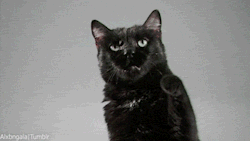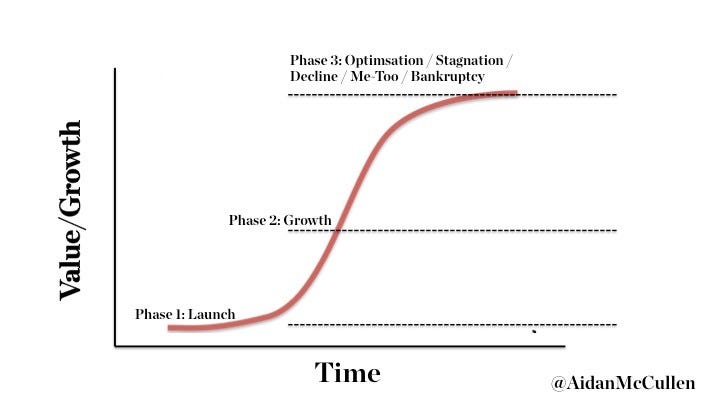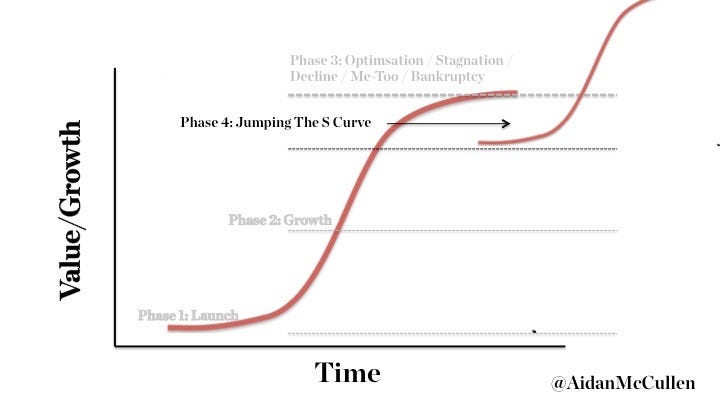
”The wise man does at once what the fool does finally.” — Niccolo Machiavelli
A farmer is sitting on his porch in a chair, hanging out.
A friend walks up to the porch to say hello and hears an awful yelping, squealing sound coming from inside the house.
“What’s that terrifyin’ sound?” asks the friend.
“It’s my dog,” said the farmer. “He’s sittin’ on a nail.”
“Why doesn’t he just sit up and get off it?” asks the friend.
The farmer deliberates on this and replies:
“Doesn’t hurt enough yet.” — Amanda Palmer (The Art of Asking)
I share this story because it reflects the fact that the majority of businesses do not react to the future until it is too late until they are on a burning platform until it hurts enough.
It is as if the idea, the innovation, the initiative goes into a time warp, only to appear years later after the business has been disrupted. The pattern is almost always the same, it can be encapsulated by Jack Welch when he said: “If the rate of change on the outside exceeds the rate of change on the inside, then the end is near.”
Too Late
S curves are a great way to describe and map the performance of a company or a product over a period of time. S curves follow the shape of the letter S with a flat growth at the start. Rapid growth comes next, followed by a dominant position in the market.
After the rapid growth, businesses or products start to plateau and experience stagnation, process optimisation, automation job cuts and quite often a me-too proposition.
To Innovate Companies and Leaders need to jump from one S curve to another, but few have the courage to do so. The jump always looks like a step backwards.
When business realise they need to jump to a new curve it is often too late. Why too late? Their leadership rightly believed its job was to protect shareholder value, but the way they go about this is to protect the current revenue stream and the business in its current form. Real leadership can be demonstrated by influencing the board, shareholders and managers that they must support an investment in discovery and exploration.
This exploration must be done before it is ever a necessity. It must be done concurrently to current growth. This makes sense, right? But why do businesses overlook this approach?
Grabbing the Tail by the Cat
“A man who carries a cat by the tail learns something he can learn no other way” — Mark Twain

You know when you suggest a solution to a friend, family member or partner and they don’t heed your advice? Weeks, months, even years pass by and out of the blue, they strike up a conversation with you. You are confused by the topic. They are now sometime later telling you how an acquaintance, parent or even a podcast interview suggested a certain solution to their problem and they think it is great advice.
Eh! Wait a second! That was exactly what you had told them? That was exactly what you warned them about! That was your advice replayed back to you as their idea, as their realisation! We must accept that the only way for people to come to their own conclusion is that they experience enough pain to make a change, they must experience the pain or at least touch the void or possible catastrophe. Many of us are wired to change only when things go haywire or show all the obvious signs of doing so.
Many of us have experienced this in our personal lives. Others of us have experienced this in the business setting. Most (if not all) digital, innovation and organisational transformation workers, corporate mavericks and change makers have experienced this in their business lives.
You know how this one goes… You suggest a certain direction, a step-change innovation, an advised initiative — the idea receives initially feigned interest, but eventually peters out and dies.
You leave the company out of frustration.
You see your ideas implemented a few years after you have left, but it is often too little — too late, their industry has already been disrupted. Their revenues have been massacred by digital disruption or some new upstart who is infinitely more agile than they are, a startup which has adapted to the market.
Hopefully, you don’t dwell on these failures (they are baggage), but you do secretly think to yourself, that is what they get for not listening to you!
After all, it is all their fault, right?
The Semmelweis Effect
“The human mind treats a new idea the same way the body treats a strange protein; it rejects it.” — P.B. Medawar
The Semmelweis effect is a metaphor for the tendency to reject new evidence or new knowledge because it contradicts established norms, beliefs or paradigms.
The term refers to the plight of Hungarian physician, Ignaz Semmelweis. In 1847, he discovered that childbed fever mortality rates fell ten-fold when doctors washed their hands with a chlorine solution between patients — or, most particularly, after an autopsy (physicians performed autopsies on every deceased patient). Semmelweis’s decision stopped the ongoing contamination of patients — mostly pregnant women — with “cadaverous particles”, saving them from infection and death.
Semmelweis’ theory makes sense to us today because we were born into the hand-hygiene paradigm. In contrast, in the 1840’s doctors could not see beyond the limits of their current paradigm. In their minds, people died from air-borne bacteria (the defunct miasma theory), not by bacteria transmitted by the hands of gentlemen!
And so it was that Semmelweis’ fellow doctors rejected his hand-hygiene theory and labelled him a quack.
Those working in transformation will have the scar tissue of the Semmelweis effect and indeed empathise with Semmelweis. However, as this week’s guest on the innovation show, Greg Satell tells us much of the blame falls on Semmelweis himself. But Why?
Reframing the Job of the Innovator
Many innovation, digital and transformation workers will feel frustration and anger towards the organisation they work(ed) for/with. If only the organisation would wake up and smell the coffee, the business model of today will not sustain the business tomorrow! The people who got us to where we are today are not necessarily the people who will get us to where we need to be tomorrow! The startups are eating our lunch slowly, death by a thousand cuts. Why, oh why can’t they see it? I have said this over and over again!
We need to think about this in a different way. We need to reframe how we tell them! Coming up with the next idea is actually the relatively easy part. The really hard part is convincing the business, the investors and the customers that the innovation is worth adopting.
“The leaders of the old paradigm have difficulty in embracing the new.” — Don Tapscott
Put another way, business leaders are optimising what got the business to where it is today (the top of the S curve), through automation, efficiencies and market positioning.
Previous innovation show guest Joel Schwartzberg tells us that when we are making a point, delivering a speech or arguing a hypothesis the burden for “being understood” is ours, the speaker, but many of us put that burden on the audience.
As Greg Satell tells us people are not just waiting around for our ideas, even if they might save the business. Their jobs are not designed to just accept our ideas. Our job is to adapt the idea, mould it and make it fit the current strategic direction, which will make it infinitely more acceptable.
This is often why innovation gets lost in the corporate time warp.
When we consider that we are effectively hanging our hat on a future direction, we need to bear in mind that that direction always takes longer to materialise than we expect.
Even more importantly, we must realise that we must change the organisational mental model in order to change the business model. Scaremongering with end-of-days predictions, case studies and thought leader articles does not work. Positioning the new initiatives as a low-risk experiment is often a better tact. Positioning the initiative as avoiding a loss rather than an incremental gain (loss aversion bias) should also be considered.
I hope this Thursday Thought presents a need for not only innovation and exploration but for the positioning of innovation and exploration. Having the idea is one thing, communicating your claim effectively is another, having the idea implemented that is a whole other challenge.
Having the world’s best idea will do you no good unless you act on it. People who want milk shouldn’t sit on a stool in the middle of the field in hopes that a cow will back up to them.” — Curtis Grant
Change will happen, that is the one constant that we can be sure about. We can use change as a map. The challenge for the changemaker is to influence the change before it appears necessary to the business. In doing so, we meet the future on our own terms.
“…Change will come. It may start as a distant rumour, a noise from outside your small world, or an unexpected intrusion within it, an invasion, signalling the existence of another world. It might be a summons or a death sentence or a calling or an offer, a win or a loss, a catastrophe or an epiphany, or merely an accumulating chain of small events. Sooner or later, however, your current world will change, the present season will end. No one said it was going to be easy.” — from “How We Are “ by Vincent Deary
IF YOU LIKE THIS POST, PLEASE SHARE IT SO OTHERS MIGHT SEE IT
This week’s innovation show is EP 118: Mapping Innovation: A Playbook for Navigating a Disruptive Age with Greg Satell
“Every Square-Peg Business Eventually Meets Its Round-Hole World.” — Greg Satell
On this episode author, speaker and consultant Greg Satell shares with us the principles of his latest book: Mapping Innovation. In this show we discuss:
How so-called geniuses Einstein, Darwin and Fleming needed more than their individual genius to bring their ideas to life
Why innovation fails
A better understanding of innovation by dispelling myths
How Blockbuster, Kodak and others were well aware of the threats that disrupted them
How Air BnB and Hotels serve different market needs
New tools to frame problems
How innovation in the digital age has evolved from previous times
How collaboration is king
Highlight that you need to re-energise your human capital not just your technological resources
Why we need a personalised portfolio approach to our innovation efforts
How Google, Amazon and others prepare for their eventual cash cow disruption
Have a Listen:
Soundcloud https://lnkd.in/gBbTTuF
Spotify http://spoti.fi/2rXnAF4
iTunes https://apple.co/2gFvFbO
Tunein http://bit.ly/2rRwDad
iHeart http://bit.ly/2E4fhfl
You can learn more about Greg here:
https://www.digitaltonto.com/about/
#GregSatell #MappingInnovation #Disruption #Banking #AirBnB #Netflix #Blockbuster #Amazon #Google #Collaboration #Ecosystems #Innovation #Transformation #DigitalTransformation #InnovationManagement


